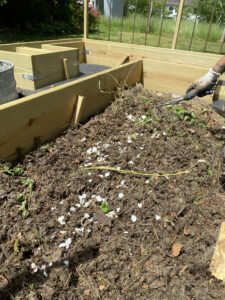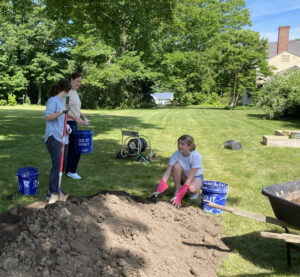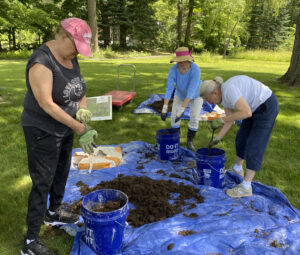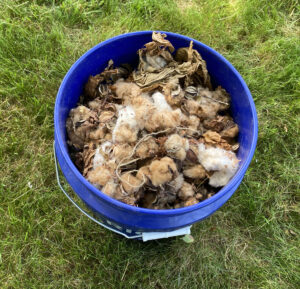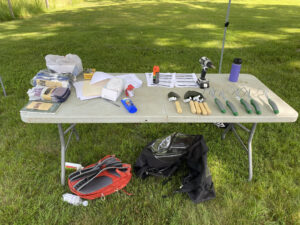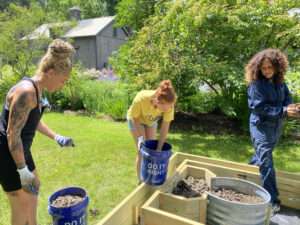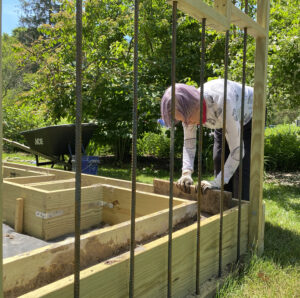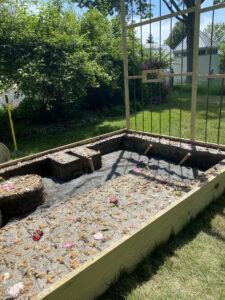- The Museum will be closed Sunday, April 9 in observance of Easter.
As part of our 2021 exhibition Social & Solitary: Reflections on Art, Isolation, and Renewal, the Museum collaborated with the New Orleans-based artist jackie sumell to install one of her “Solitary Garden” beds on our grounds. Volunteers worked with the artist to create the fixtures and plant the garden.
The Solitary Garden project comes to life through correspondence between a volunteer and a currently incarcerated “gardener.” Their letters articulate to the Museum what kinds of flowers or plants are grown in the garden bed. Each Solitary Garden is a gesture of hope connecting an isolated person to the outside world through the restorative act of nurturing plants.
The size and layout of sumell’s 6’ x 9’ plots replicate prison cells, with “fixtures” made from biodegradable materials that will disappear over time as the plants and flowers mature.
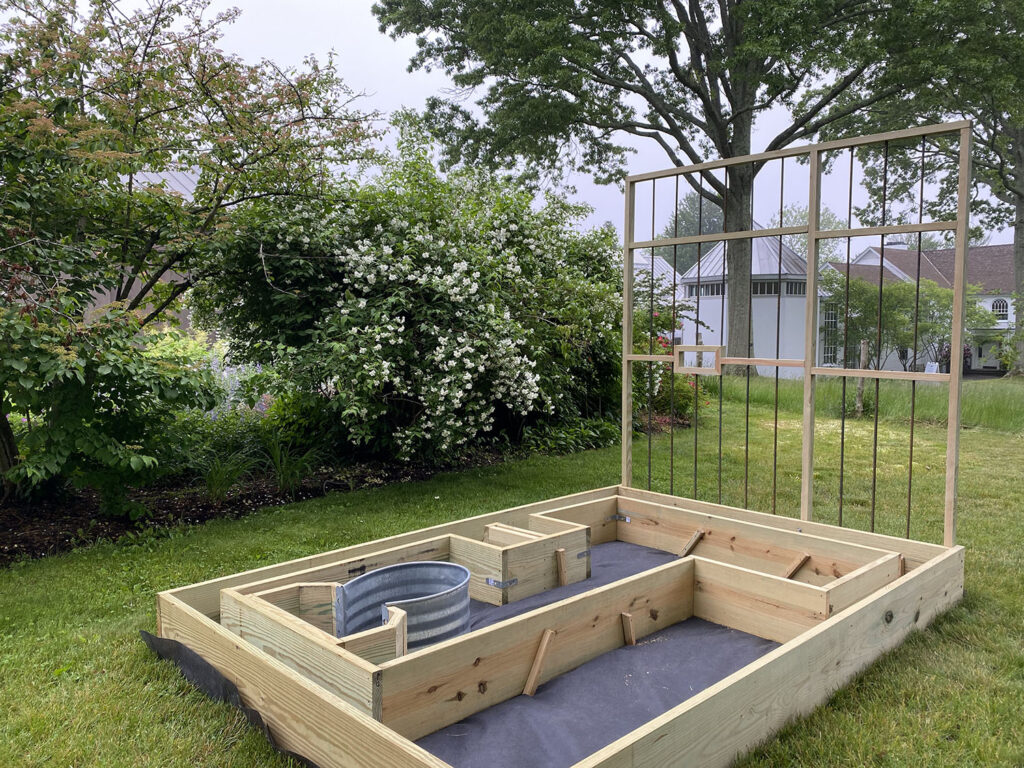
The artist focuses her work on the effects of prison and is interested in the empathy the gardens can help cultivate for the incarcerated.
About Solitary Gardens
The Florence Griswold Museum in Old Lyme is collaborating with the New Orleans-based artist jackie sumell to install one of her “Solitary Garden” beds on our grounds, in conjunction with the exhibition Social & Solitary: Reflections on Art, Isolation, and Renewal. The Solitary Garden project comes to life through correspondence between a volunteer and a currently incarcerated “gardener.” Their letters articulate to the Museum what kinds of flowers or plants are grown in the garden bed. Each Solitary Garden is a gesture of hope connecting an isolated person to the outside world through the restorative act of nurturing plants. The gardens become extensions of the incarcerated person in the community—creative and positive expressions of beauty, healing, and rehabilitation that volunteers enact on behalf of the “gardener.” The size and layout of sumell’s 6’ x 9’ plots replicate prison cells, with “fixtures” (including a bed and toilet) made from biodegradable materials that will disappear over time as the plants and flowers mature. The artist focuses her work on the effects of prison and is interested in the empathy the gardens can help cultivate for the incarcerated.
sumell began her work on prisons with a 12-year collaboration with Herman Wallace, who ultimately spent four decades in solitary confinement in Louisiana prisons. The artist wrote him a letter to ask “What kind of house does a man who has lived in a six-foot-by-nine-foot box for almost thirty years dream of?” The result was their joint project The House That Herman Built (Herman’s House), a travelling exhibition, book, advocacy campaign, and Emmy Award-winning documentary (Best Artistic Documentary, 2013). Wallace’s conviction was overturned after 41 years and he was released from prison on October 1, 2013. He died only days later from cancer. Dedicated to keeping Herman’s story alive, sumell developed The Solitary Gardens. These installations turn solitary confinement cells into garden beds that are the same size and blue-print as the cell Herman, and countless others, occupied for decades.
Check back often for progress on the garden – or sign up through the gold bar below to receive our twice monthly e-newsletter for updates.
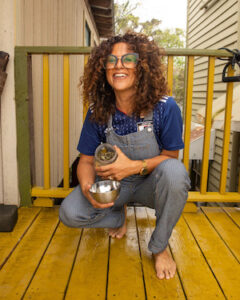
“As the garden beds mature, the prison architecture is overpowered by plant life, proving that nature—like hope and compassion—will ultimately triumph over the harm humans impose on the planet.” The artist focuses her work on the effects of solitary confinement to “catalyze compassion,” public awareness, and to lend support for efforts to end the practice.” — artist jackie sumell
FAQ
About the project
How did the museum choose to work with artist jackie sumell?
The Museum’s summer 2021 exhibition, Social & Solitary: Reflections on Art, Isolation, and Renewal, draws from the Museum’s permanent collection to explore the effects of the coronavirus pandemic. Exhibition co-curator Amy Kurtz Lansing sought to add a work by a contemporary artist who considers themes of solitude in their practice, in recognition of the isolation imposed in the interest of health during pandemic. Surveying the field, she encountered artist jackie sumell’s work, with its compelling emphasis on the human toll of solitary confinement and its commitment to creating connections between an incarcerated person and the outside world through the medium of nature. In conversation with the curator, sumell explained her focus on social transformation and healing, which feel so necessary in processing the events of this past year. The artist tends the original Solitary Gardens in New Orleans’s Lower Ninth Ward. She also collaborates with nonprofits and institutions around the country to make social sculptures and collective projects that foster conversations about alternatives to incarceration and catalyze compassion in the interest of encouraging us to consider a landscape without prisons. Both her recognition of hard truths and her optimism for the transformative potential of Solitary Gardens made her an ideal artist to commission for this exhibition.
Can you tell me more about the incarcerated gardener? How were they chosen?
The gardener is currently incarcerated at the York Correctional Institution, a facility for women in Niantic. By pending agreement with the prison and the gardener, we will soon be able to share the gardener’s initials. Artist jackie sumell works with gardeners incarcerated around the country and encouraged the curator to connect with someone in prison locally. The Hartford artist Judy Dworin of the movement-based, multi-arts Judy Dworin Performance Project works with women incarcerated at York and helped identify the gardener based on her past involvement in both gardening and writing programs at the prison.
Who will write the letters?
The Museum put out a call for a volunteer to exchange letters with the incarcerated gardener. The letter writer has past experience working with incarcerated women.
How long will the garden bed be in place?
The Solitary Garden will be in place through the end of the growing season in 2023. The artist fills the bed with biodegradable material, so it is intended to decay over time. The cell bars will become less visible under growing vines.
Why is the Solitary Garden located on this spot?
We chose this location for both practical and symbolic reasons. We installed the Solitary Garden next to our historic garden for easy access to water from our hose. We also sought a flat spot for ease of construction, and built the garden where it would not conflict with existing activities on our site. The Solitary Garden can also be seen against the backdrop of the Florence Griswold House, where Miss Florence once employed as a maid Marie (last name unknown), a former prisoner from the Connecticut State Farm and Reformatory for Women, now called York Correctional. The artist indicated that Solitary Garden should be positioned so that one will encounter the cell bars first, as you would inside a prison.
Who takes care of the garden?
Volunteers tend the garden. Please let the front desk know if you would like to pitch in!
What plants will be included?
The garden bed will first be planted with a cover crop, which will soon be turned into the soil to enrich it. Next, plants chosen by the incarcerated gardener will go in, along with flowers like those that grew in Florence Griswold’s historic garden. Other Solitary Gardeners have requested plants that that remind them of favorite foods or family traditions. Many select herbs and flowers that can be transformed into tonics and teas that target stress and build health in the face of the physical and mental effects of imprisonment. The artist works with these ingredients as part of the “Prisoner’s Apothecary,” her program of transforming plants into medicine for communities most affected by mass incarceration. In this way, the imprisoned gardeners have, in sumell’s words, ”a unique opportunity to heal the communities they are often accused of harming” in the spirit of “restitution and redemption.”
What is the garden bed made of? How was it created?
The garden was created by artist jackie sumell with the help of volunteers over three days in June 2021. Before the artist arrived on site, sumell advised Museum staff and a carpenter on how to build the template for the garden “cell.” She offers plans for the forms and is open to her collaborators coming up with solutions for how to build the components like the cell doors. While some of her Solitary Gardens have welded metal doors, which will serve as a trellis for climbing plants, others are built of wood. Ours is a combination of wood and metal rebar.
During her site visit, sumell instructed the volunteers on how to complete the bed. The “walls” and “furniture” in the cell are made from what she calls “Revolutionary Mortar.” That material is composed of the largest crops once produced for sale using enslaved labor: sugarcane, cotton, indigo, and tobacco—symbolism sumell chose to tap into the historical roots of mass incarceration. The ground-up plants (“bagasse”), which the artist grows in Louisiana, are mixed with natural lime and water by volunteers. To build the garden walls, the Revolutionary Mortar is tamped down in a rammed-earth process typically used in traditional and “green” construction. As the artist explains on her website, the tamping of the plant-based mortar into the shape of a jail cell illustrates “the evolution of chattel slavery into mass incarceration.“ She adds, “The PROCESS is critical to transformation. It allows us as volunteers to engage in meaningful conversation“ and “to process collectively.” She goes on to say, “As a result of this process The Solitary Gardens are ’alive’ and the walls change over time, off-setting the footprint of prisons made of concrete and steel. As the garden beds mature, the prison architecture is overpowered by plant life, proving that nature—like hope, love, and imagination—will ultimately triumph over the harm humans impose on ourselves and on the planet.“
How can I learn more about solitary confinement and the effort to end its use in prisons?
Solitary confinement is defined by the United Nations as ”confinement of prisoners for 22 hours a day or more without meaningful human contact.” The U.N. has indicated that “prolonged solitary confinement of 15 or more consecutive days is considered a form of torture.” StopSolitaryCT.org is the website for the campaign to end solitary confinement in Connecticut, and to replace it with humane, effective alternatives. A bill ending the practice was approved by the state senate on June 4, 2021.
Where can I see other Solitary Gardens?
In New England, the Harriet Beecher Stowe Center in Hartford is home to a Solitary Garden this summer. Looking ahead, Wheaton College in Norton, Mass., will be working with sumell this academic year. SolitaryGardens.org lists the locations of other gardens by the New Orleans-based artist.
Is this the Museum’s first outdoor sculpture?
No, the Museum is committed to continuing the legacy of artistic creativity on our site begun by the members of the Lyme Art Colony hosted by Florence Griswold. We have presented two site-specific outdoor sculptures. In 2009, we commissioned sculptor Patrick Dougherty to create The Rambles, a large stick-work structure built with volunteer assistance during a 3-week residency. In 2013, artist Matthew Geller installed The Anticipator, which repurposed the trunk of a magnolia tree that had been planted by Florence Griswold into a sculpture with flowers that emitted light and mist to change the surrounding environment and to prompt conversation. This season, we have collaborated with the neighboring Roger Tory Peterson Estuary Canter to provide space for Artist-in-Residence Dana Sherwood to film nocturnal animal banquets in preparation for artwork that she will exhibit at the Museum in summer 2022. Ask at the front desk for more information about that project.
Why is artist jackie sumell’s name in lowercase letters?
No, it’s not a typo! The artist answers that many people, such as feminist scholar bell hooks, civil rights expert and law professor john a. powell, and the writer adrienne maree brown do not capitalize their names. Says sumell, for them, “it is both stylistic and political. I choose not to capitalize my name for similar reasons—both as a way to suggest that what matters is the work, not the artist, and as a stance against my own experience with oppressive grammatical rules that have suggested I am less than brilliant.”

